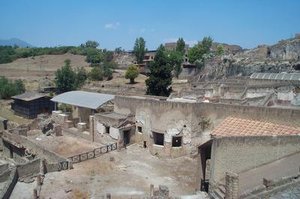Herculaneum
|
|
Herculaneum (modern Italian Ercolano) was an ancient Roman town of the Italian region of Campania. It is today most famous for having been preserved, along with Pompeii, in the eruption of Mount Vesuvius beginning on August 24, A.D. 79 that destroyed the towns, burying them in ash that has hardened into volcanic tufa. A pyroclastic flow preceded the main eruption, killing many residents, whose bodies were encased in ash that preserved their last moments in casts. In contrast to Pompeii, Herculaneum was a smaller town with a wealthier population at the time of its destruction.
Excavation began at modern Ercolano, a suburb of Naples, in 1738. The elaborate publication of Le Antichità di Ercolano ("The Antiquities of Herculaneum") under the patronage of the King of the Two Sicilies had an effect on incipient European Neoclassicism out of all proportion to its limited circulation; in the later 18th century, motifs from Herculaneum began to appear on stylish furnishings from decorative wall-paintings and tripod tables to perfume burners and teacups.
Ercolano1_Copyright2003KaihsuTai.jpg
The first major discovery of 1st century A.D. Roman skeletal materials took place in Herculaneum. Because the Romans generally practised cremation into the 3rd century, very little skeletal material remains for study. Excavation during the 1990s in the port area of Herculaneum turned up the skeletons of more than 200 individuals of varied age, sex, and class.
Ercolano2_Copyright2003KaihsuTai.jpg
Ring_Lady.JPG
The most famous of the luxurious villas at Herculaneum is the 'Villa of the Papyri' now identified as the magnificent seafront retreat for Lucius Calpurnius Piso Caesoninus, Julius Caesar's father-in-law. It stretches down towards the sea in four terraces. Piso, a literate man who patronized poets and philosophers, built there a fine library, the only one to survive intact from antiquity. Scrolls from the villa are stored at the National Library, Naples. The scrolls are badly carbonized, but a large number have been unrolled, with varying degrees of success. Computer-enhanced multi-spectral imaging (http://www.memagazine.org/backissues/apr02/departments/input_output/input_out.html), in the infra-red range, helps make the ink legible. There is now a real prospect that it will be possible to read the unopened scrolls using X-rays.[1] (http://www.research.uky.edu/odyssey/fall04/seales.html) The same techniques could be applied to the scrolls waiting to be discovered in the as yet unexcavated part of the villa, removing the need for potentially damaging unrolling to be carried out.
External links
- The Friends of Herculaneum Society (http://www.herculaneum.ox.ac.uk)
- Herculaneum: Destruction and Re-discovery (http://www.romanherculaneum.com)
- The local archaeological authorities (http://www2.pompeiisites.org/)
- The Philodemus Project will publish Philodemus' works on poetry and on rhetoric. (http://www.humnet.ucla.edu/humnet/classics/philodemus/philhome.htm)
- Brigham Young University: Herculaneum Scrolls (http://magazine.byu.edu/article.tpl?num=44-Spr01)da:Herculaneum
de:Herculaneum fr:Herculanum it:Ercolano nl:Herculaneum ja:エルコラーノ pl:Herkulanum pt:Herculano fi:Herculaneum sv:Herculaneum

